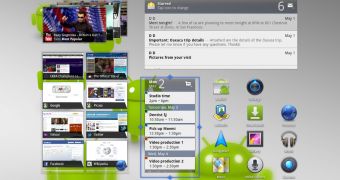A new flavor of Android is now available at large, namely Android 3.1 Honeycomb, already rolling-out on Motorola XOOM devices as an incremental release. The new Android version was announced during the first day at the Google I/O developer conference, as the next major release for tablet PCs, sporting a user interface optimized for the larger screens of these devices.
[admark=1]The new Android 3.1 OS comes with a series of new features when compared to the Android 3.0 platform, and also refines some of the capabilities that Google included in that iteration. It also aims at making the UI more intuitive and more efficient to use.
The UI transitions in the new Android 3.1 platform were improved throughout the system. Moreover, the Launcher animation offers faster transition, to and from the Apps list, which adds to improved accessibility with audible feedback throughout the UI.
The list of new features packed with the new platform version would include:
- Open Accessory API. This new API provides a way for Android applications to integrate and interact with a wide range of accessories such as musical equipment, exercise equipment, robotics systems, and many others.
- USB host API. On devices that support USB host mode, applications can now manage connected USB peripherals such as audio devices. input devices, communications devices, and more.
- Input from mice, joysticks, and gamepads. Android 3.1 extends the input event system to support a variety of new input sources and motion events such as from mice, trackballs, joysticks, gamepads, and others.
- Resizable Home screen widgets. Developers can now create Home screen widgets that are resizeable horizontally, vertically, or both.
- Media Transfer Protocol (MTP) Applications can now receive notifications when external cameras are attached and removed, manage files and storage on those devices, and transfer files and metadata to and from them.
- Real-time Transport Protocol (RTP) API for audio. Developers can directly manage on-demand or interactive data streaming to enable VOIP, push-to-talk, conferencing, and audio streaming.
According to Google, these new additions are aimed both at users and developers. At the same time, they announced that the Open Accessory API was made available on a wider variety of devices, and that it was backported to Android 2.3.4 as an optional library.
Nexus S by Samsung is the first Android device to offer support for the new feature. Developers would be able to access the 2.3.4 version of the Open Accessory API through the updated Google APIs Add-On.
In addition to the new platform releases, and the correspondent SDKs, Google also made available a new version of SDK Tools, now r11. Additional info on the new platform release can be found on the Android developer website here.
To get started with the development for Android, one would need to download the said SDKs, available from Softpedia too, via this link.
As stated above, the first device to benefit from the enhancements Google packed with the new platform release was the Motorola XOOM. An update to the new Android 3.1 platform is already rolling out to it.

 14 DAY TRIAL //
14 DAY TRIAL //